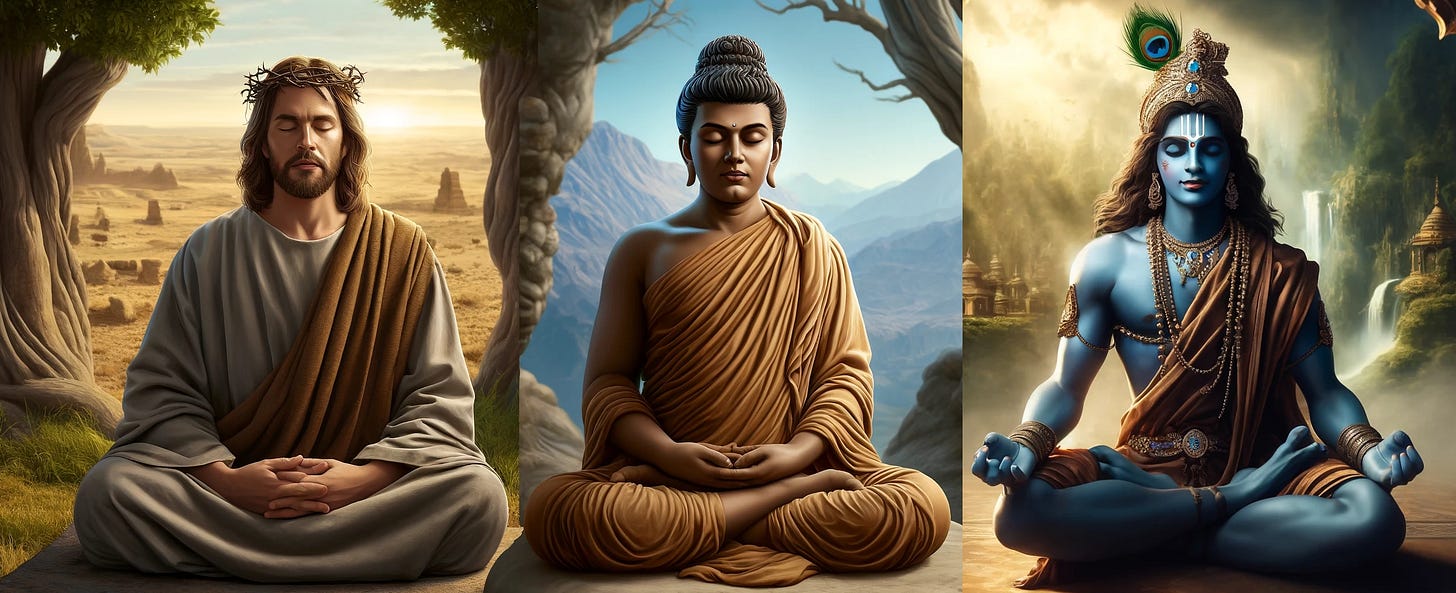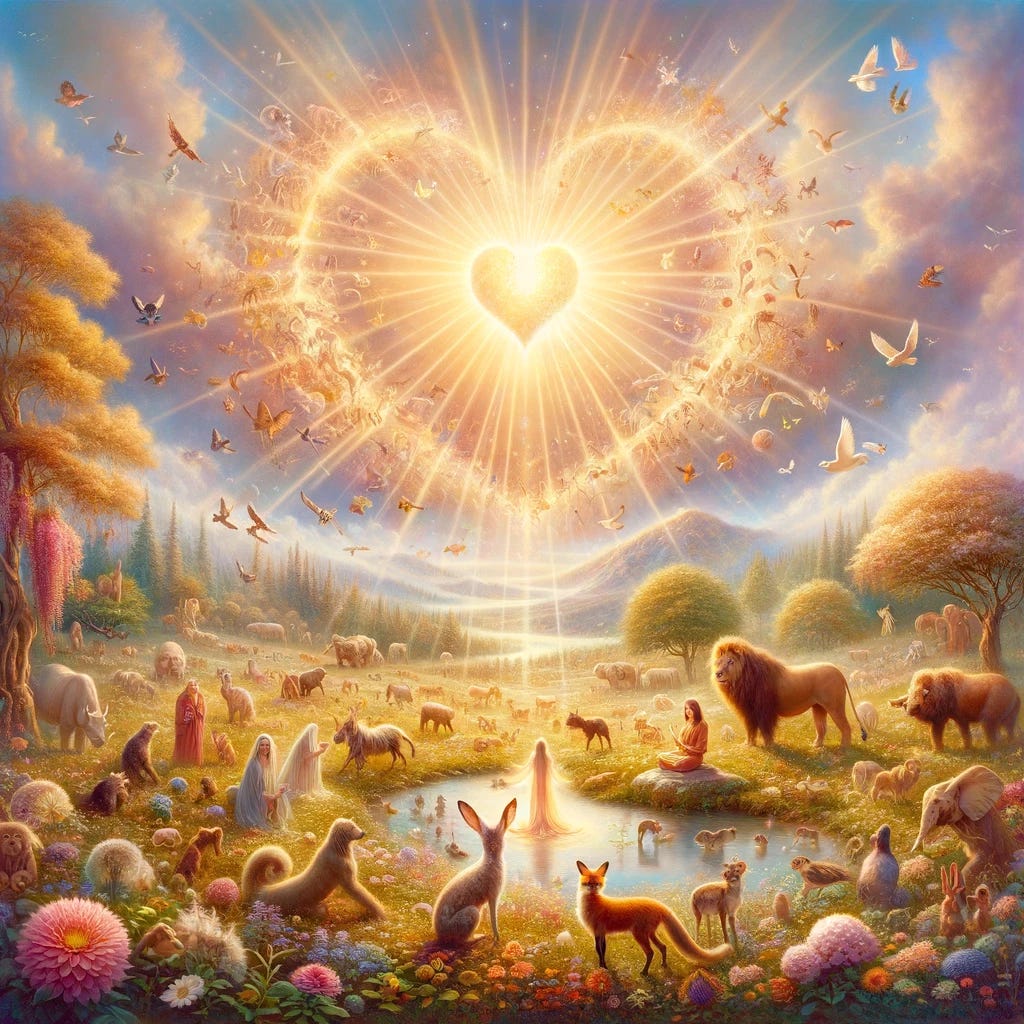Author’s Note: Spiritual Instagram has revealed a startling lack of understanding about the similarities between the founding religious figures—whom Yogananda, many Hindus & mystics, along with myself, consider to be Avatars of the Divine. Who are they and what do they teach? Here’s my take with academic citations included.
To be clear, this is a short excerpt from my book Original Sin Is A Lie: How Spirituality Defies Dogma and Reveals Our True Self. I am the writer, owner, and publisher so I can put it wherever the hell I want. The following section omits the biographies of each figure within the book—I’m jumping straight into the overlapping teachings for the sake of brevity. I hope you enjoy… even just formatting these powerful quotes from our elder brothers gave me chills.
🕉🕎✝️☪️☯️☸️
The avatar is a human manifestation of the Divine, born out of Absolute Compassion to serve and illuminate the rest of humanity.1 They teach us to realize our True Nature. Almost every system of religious or spiritual belief contains divine, or awakened personas who guide the rest of us stuck in primal mud.
The term comes from Sri Krishna in the Bhagavad Gita, who comforts his cousin Arjuna with the following:
“Whenever righteousness wanes and unrighteousness increases I send myself forth.
For the protection of the good and for the destruction of evil,
and for the establishment of righteousness, I come into being age after age.”
—Krishna, Bhagavad Gita 4.7–8
Human civilizations rise and fall. Everything in the world of form happens in a cyclical framework.
During the peaks, humanity experiences harmony and brotherhood in the world. During the valleys, when evil takes over, a spark of divinity ignites within a human being who is intimately connected to our Creator, that ultimate Cosmic Energy from which all things spring.
This Manifestation of Light centers their entire human life around teaching how to liberate us from our earthly bondage.
The plot points of their lives are eerily similar: all avatars have wondrous births. Their coming is prophesied by sages. As youth, they radiate compassion and knowledge far beyond their years. They correct institutional hypocrisies and misdeeds. And they ultimately teach us how to walk the path of peace and love.
“All human beings are potential gods; the wise man and the ignorant one both are true image-incarnations of God. The Divine Omnipresence fills each soul-image even as the mighty ocean is present in each wave. However, unless a wave dissolves itself and becomes one with the ocean, it remains inordinately limited. Until a devotee is fully liberated, he cannot truly assert: ‘I and my Father are one.’”2
—Paramahansa Yogananda

Quite simply (reductively), the primary mystical messages of each of these avatars are:
• The Path to Peace and its Internal Nature
• Compassion to All Beings
• Releasing Dependence on the External World
There are entire libraries dedicated to the teachings of these ancient masters so I'm only offering a meager flyover summary here, but a basic understanding of these teachers' parallels is important for the avenues and alleyways we'll be traveling in later pages. And of course, our lives at large.
On the Internal Path:
While the Gita is set on a battlefield of an epic war, for centuries yogic masters have interpreted this conflict as being two armies at war within one's mind: sensual egoic thinking vs. the illumined Self. The raging battle of Kurukshetra is merely the metaphor used for Krishna to guide his cousin Arjuna through a series of conceptual precepts and practical techniques leading to transcendence. Yogananda and others have even interpreted every major character in the Mahabharata as a symbolic representative of a unique aspect of self!3
The method Krishna prescribes for avoiding temptation is self- control through meditation as well as the mental withdrawal from their importance.
“O Mighty-Armed Arjuna, undoubtedly the mind is fickle and unruly;
But by yoga practice and by dispassion, the mind may nevertheless be controlled.
This is My word: Yoga* is difficult of attainment by the ungoverned man;
but he who is self-controlled will, by striving through proper methods,
Be able to achieve it.”
—Krishna, Bhagavad Gita 6.35-36
*Yoga as defined by Patanjali in the fourth century CE, is "the stilling of the mind fluctuations", the discipline to do so. Not quite modern 'American gym yoga' but its ancient antecedent.
This avoidance of external temptation is a key feature in the map of the hero's journey. It's an important plot point in their life story because it affirms their greatness. And the overcoming itself has a transformative power.
After his baptismal initiation by John the Baptist, Jesus walked off into the desert to be tested for forty days by Satan, who offers him different offerings of power and prestige, all of which he refused. In an especially striking parallel, the Buddha sat under the Bodhi tree for forty days, as Devaputra Mara ("chief of demons") offers him pleasure and power and other external trappings, all of which he refused.
“Ask, and it will be given you.
Seek, and you will find.
Knock, and the door will be opened to you.”
—Jesus, Gospel of Matthew 7:7
“The kingdom of God does not come with observation.
Nor will they say, ‘Here it is!’ or ‘There it is!’ For remember,
the kingdom of God is within you.”
—Jesus, Gospel of Luke 17:20-21
“Let those who are wise seek the Way. Those who find it will not return.”
—Krishna, Bhagavad Gita
“Those who seek to find the One without ceasing,
will find the Lord
dwelling in their own hearts.”
—Krishna, Bhagavad Gita
“Seeking within, you will find stillness.
Here there is no more fear or attachment—only joy.”
—Buddha, Dhammapada
“Irrigators channel waters;
fletchers straighten arrows;
carpenters shape wood;
the wise master themselves.”
—Buddha, Dhammapada
On Compassion:
“Bless those who curse you.
Pray for those who mistreat you.”
—Jesus, Gospel of Luke 6:28
“A new commandment I give to you, that you love one another,
even as I have loved you, that you also love one another.
By this all men will know that you are My disciples,
if you have love for one another.”
—Jesus, Gospel of John 13:34-35
“The best type of yogi is he who feels for others,
Whether in grief or pleasure, even as he feels for himself.”
—Krishna, Bhagavad Gita 6.32
“Do everything you have to do,
but not with greed, not with ego, not with lust, not with envy
but with love, compassion, humility and devotion.”
—Krishna, Bhagavad Gita 2.45
“Radiate boundless love towards the entire world above, below, and across
unhindered, without ill will, without enmity.”
—Buddha, Karaniya Metta Sutta
“We will develop and cultivate the liberation of mind by loving-kindness,
make it our vehicle, make it our basis, stabilize it,
exercise ourselves in it, and fully perfect it.”
—Buddha, Samyutta Nikaya
On Releasing External, Worldly Desire:
“It is easier for a camel to pass through the eye of a needle than for a rich man to enter the Kingdom of heaven.”
—Jesus, Gospel of Matthew 19:24
“Therefore I tell you, do not worry about your life, what you will eat or what you will drink, or about your body, what you will wear. Is not life more than food, and the body more than clothing?
Look at the birds of the air; they neither sow nor reap nor gather into barns, and yet your heavenly Father feeds them.
Are you not of more value than they? Can any of you by worrying add a single hour to your span of life?
And why do you worry about clothing? Consider the lillies of the field, how they grow; they neither toil nor spin, yet I tell you, even Solomon in all his glory was not clothed like one of these.”
—Jesus, Gospel of Matthew 6:25-29
“When one's mind dwells on the objects of Senses, fondness for them grows on him,
from fondness comes desire, from desire anger.
Anger leads to bewilderment, bewilderment to loss of memory of true Self,
and by that loss intelligence is destroyed, and with the destruction of intelligence he perishes.”
—Krishna, Bhagavad Gita 2.62-63
“He who feels neither rejoicing nor loathing toward the glad nor the sad, who is free from grief and cravings, who has banished the relative consciousness of good and evil, and who is intently devout - he is dear to Me.”
—Krishna, Bhagavad Gita 12.17
“A mind unruffled by the vagaries of fortune,
from sorrow freed,
from defilements cleansed,
from fear liberated—this is the greatest blessing.”
—Buddha, Mangala Sutta
“I do not dispute with the world;
rather it is the world that disputes with me.”
—Buddha, Samyutta Nikaya
While the altar of my mind contains the teachings of Krishna, Buddha, and Christ, I’m not an authority on whether Abraham, Moses, Muhammad, or other famous prophets throughout history were avatars as defined as the fullest aspect of the Creator in the flesh (despite the Buddha’s agnosticism).
I know the above three and I have little need for more nourishment—they are each continental reservoirs overflowing the meager table pitcher of my heart.
That said, I fully endorse listing Abraham, Moses, Muhammad, Confucius, Zoroaster, Laozi, Socrates, Plato, Adi Shankara, Kabir, Mirabai, Bahá'u'lláh, Meister Eckhart, Guru Nanak, St. Francis of Assisi, The Great Peacemaker, Anandamayi Ma, Ramakrishna and countless others as avatars, as extremely important divine figures, prophets, sages, saints, or as the Ba'hai faith refers to many of these, “Manifestations of God”.4
I've drawn out some of the parallels between the Masks of the One most cherished to me, but in my admittedly still feeble understanding of the Infinite Nature of our Creator, categorizing these illuminated beings doesn’t seem to be very useful for conscious development.
What is useful however, is acknowledging the wisdom to be gained from each Holy Voice, and realizing that Spirit can come through in a variety of time periods and a variety of cultural backgrounds.
Ultimately the main reason I hold the avatars in such high regard is very simple: because I see the immense value in applying their teachings to practical living. There have been absolute giants of humanity who have found peace by connecting to an ever-present Divinity dwelling within themselves and the rest of creation. The fact that their teachings overlap so greatly is worth being aware of!
Karmic Relief Podcast
Gratitude for the soulful energy and momentum I’m receiving from the work on my reawakened podcast, Karmic Relief. The fourth episode from this 2024 season is up now and even editing it the other night I slipped into a beautiful mystical hypnosis… “moment by vanishing moment”… my latest guest is Timothy Conway, a scholar and devotee of the ‘pathless path’ for the over fifty years. I have ten more filmed to come out this summer. I have dozens of people to interview. I’m just getting started. Follow any of the following: YouTube channel / Spotify / Apple Podcast / Instagram to stay tuned.
This body is thirty six years old today.
May all beings be happy and free.
Kinsley, David. "Avatar." Encyclopedia of Religion. Mercia Eliade, ed. New York: MacMillan Publishing, 1987. 14-15.
Yogananda, Paramahansa. “The Supreme Science of Knowing God.” The Bhagavad Gita: God Talks with Arjuna: Royal Science of God-Realization, Self Realization Fellowship, 1995, p.440.
Pasles, Chris. “'Mahabharata'--in Condensed Form.” Los Angeles Times, 5 Oct. 1999, www.latimes.com/archives/la-xpm-1999-oct-05-me-18924-story.html.
“What Bahá'ís Believe.” Manifestations of God | What Bahá'ís Believe, www.bahai.org/beliefs/god-his- creation/revelation/manifestations-god.










So so so so good!!!!!